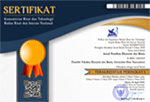Prediction of the Number of Graduates Absorption by the Field of Expertise
DOI:
https://doi.org/10.33633/jpeb.v8i2.8061Abstract
The study program accreditation process also includes reporting forms filled in with the number of graduates working according to their field of expertise. A low conformity rate will indicate a lack of training and skills for graduates. If the conformity rate is high, it will affect the results of accreditation to increase and make the level of public trust in the study program higher, as well as from the perspective of graduate staff users. The study program needs to know the data of its graduates earlier as a step to increase the compatibility rate of the field of work with the field of lectures for its graduates. These problems can be minimized by carrying out a prediction process on the suitability of graduate fields. The variable used to predict is a data series of the number of graduates working in the right field over a certain period of time. The use of linear regression for predictions in the case of determining the exact field really helps make it easier for study programs to help predict the number of students who graduate by working in the right field. This study uses a linear regression method.References
Harliana. (2017). Prediksi Jumlah Pendaftaran Calon Mahasiswa Baru Dengan Metode Regresi Linier. Jurnal Ilmiah DASI , 18, 1-5.
Katemba, P. (2017, Juni). Prediksi Tingkat Produksi Kopi Menggunakan Regresi Linear. Jurnal Ilmiah HLASH , 42-51.
Muhson, A. (2012). Analisis Relevansi Lulusan Perguruan Tinggi Dengan Dunia Kerja. Jurnal Economia , 8, 42-52.
Navian, A. (2017). Prediksi Persediaan Obat Dengan Metode Regresi Linier. Jurnal Teknik Informatika , 1-14.
Pertiwi, M. W. (2017). Metode Regresi Linier Untuk Prediksi Pengadaan Inventaris Barang. SIPNASIPTEK , 27-30.
Suhendra, A. (2019). Instrumen Akreditasi Program Studi (IAPS) 4.0.
Sulistyono. (2017). Peramalan Produksi dengan Metode Regresi Linier Berganda. Prozima , 1, 82-89.
Wulandari, N. L. (2018). Prediksi Jumlah Pelanggan Dan Persediaan Barang Menggunakan Metode Regresi Linier Berganda Pada Bali Orchid. Eksplora Informatika , 1-12.
Downloads
Published
How to Cite
Issue
Section
License
The copyright of the received article shall be assigned to the journal as the publisher of the journal. The intended copyright includes the right to publish the article in various forms (including reprints). The journal maintains the publishing rights to the published articles.
This work is licensed under a Creative Commons Attribution 4.0 International License.


.png)









